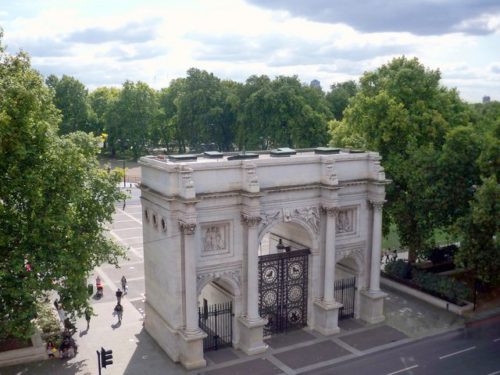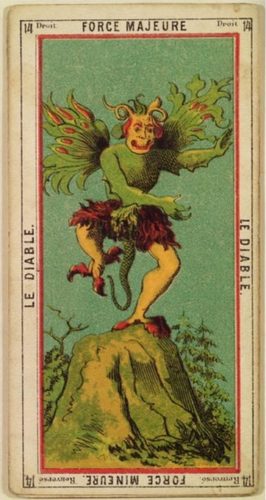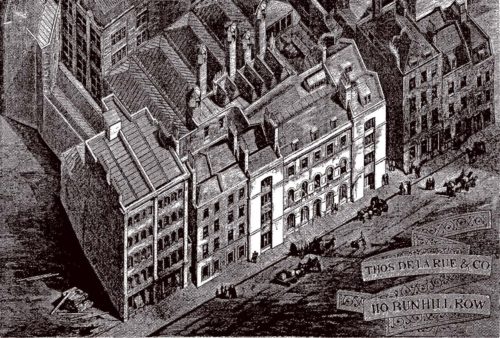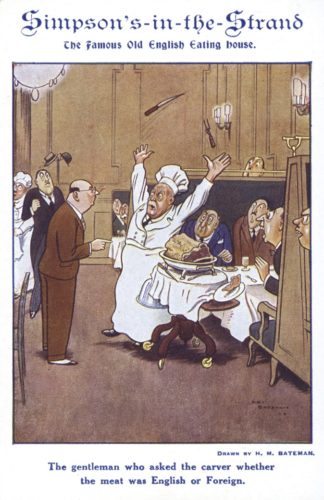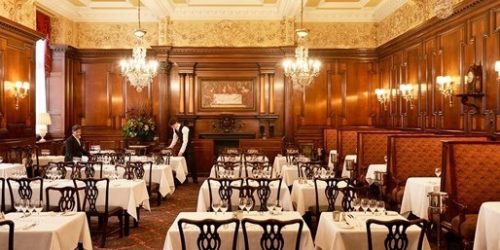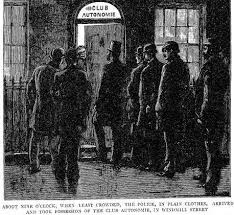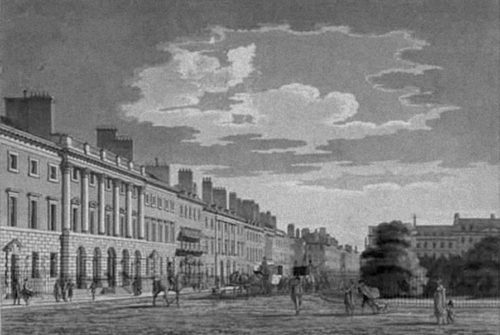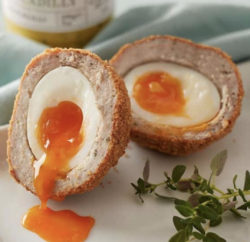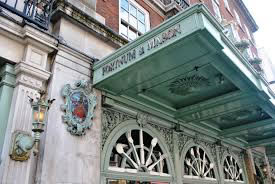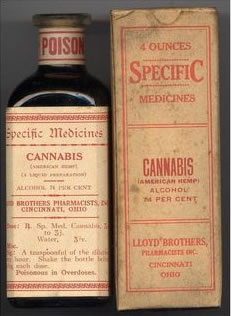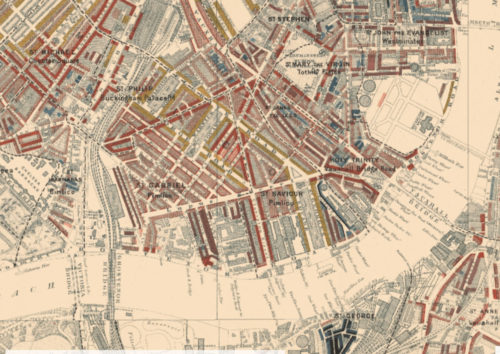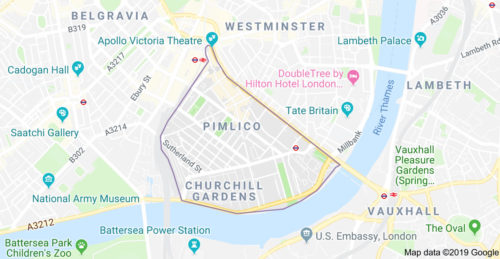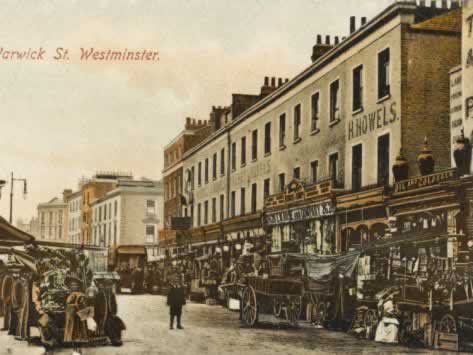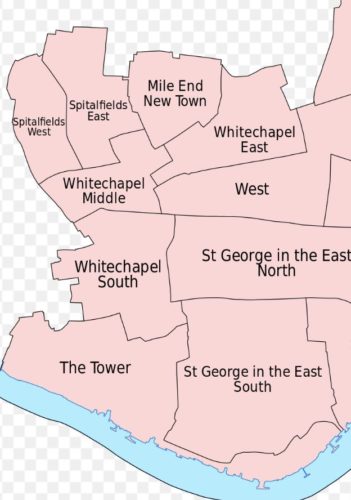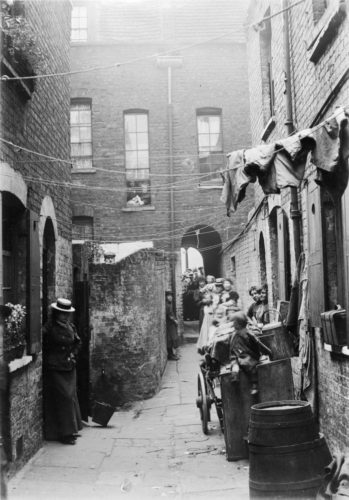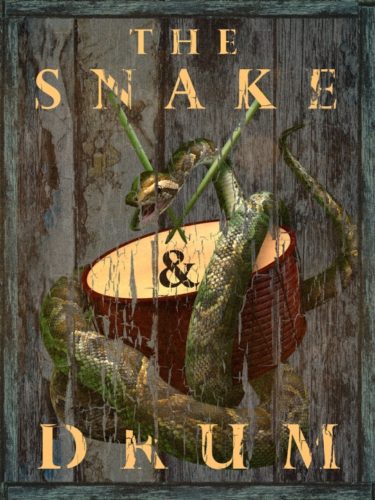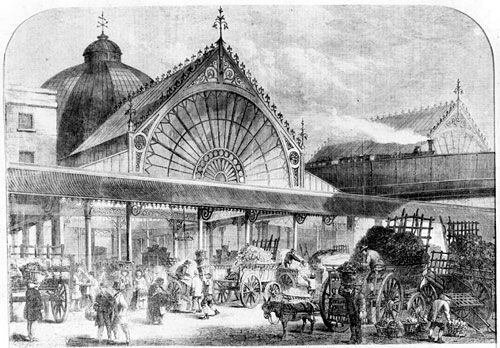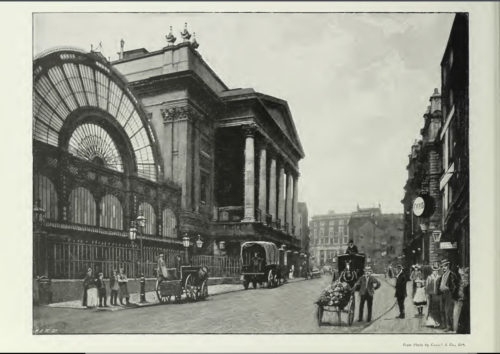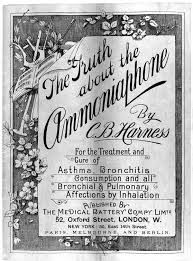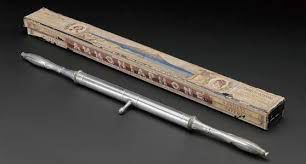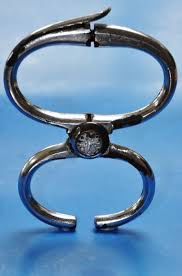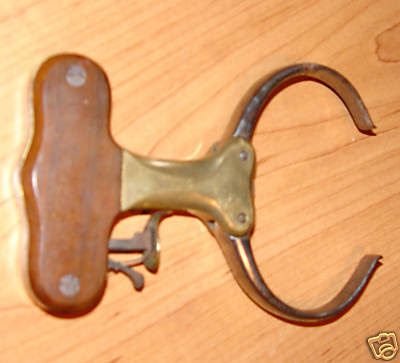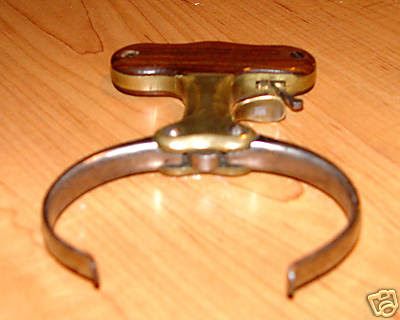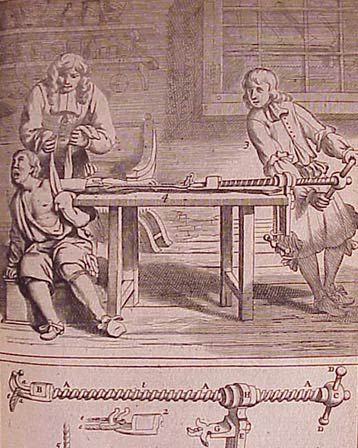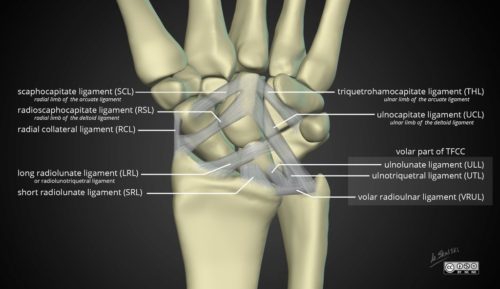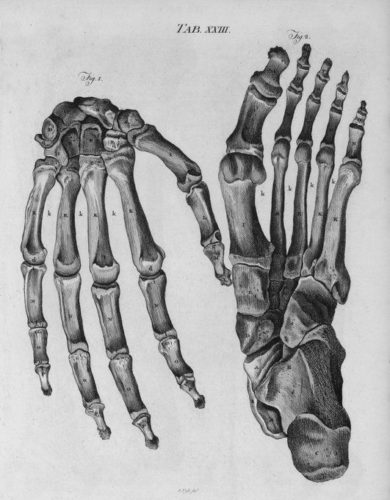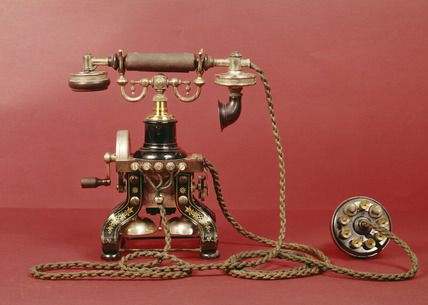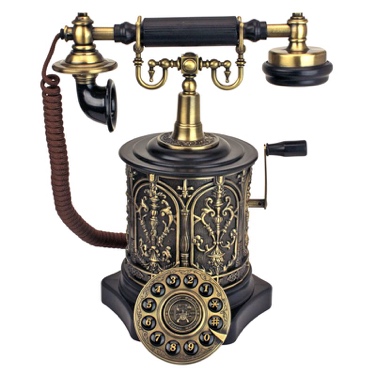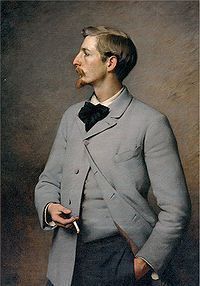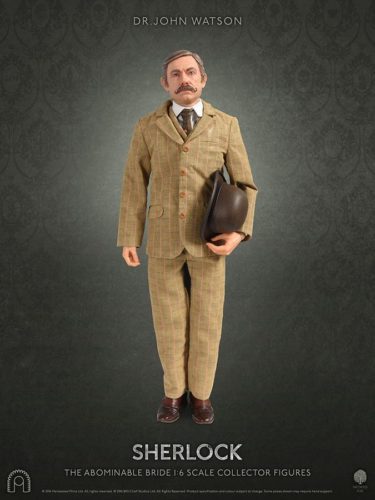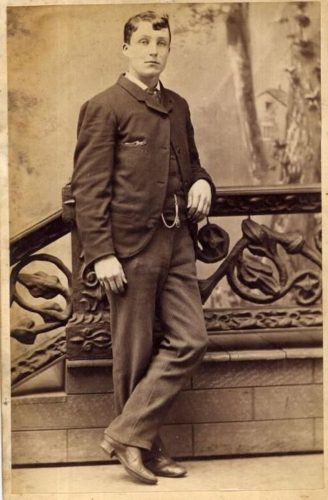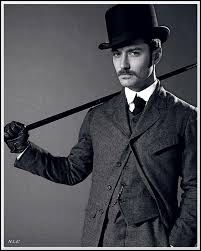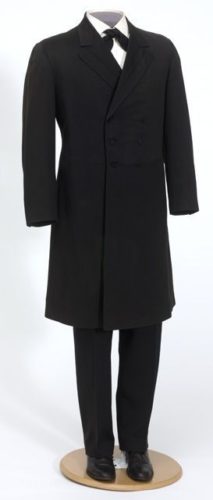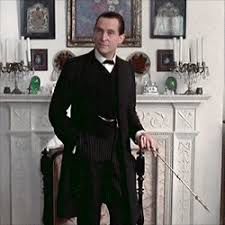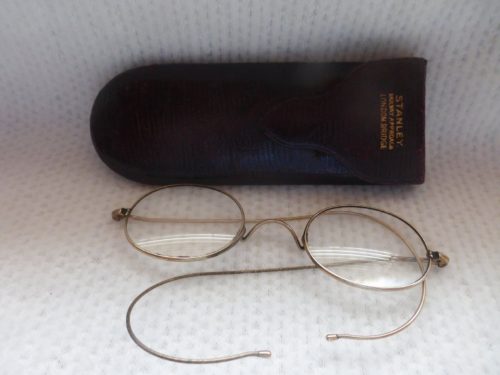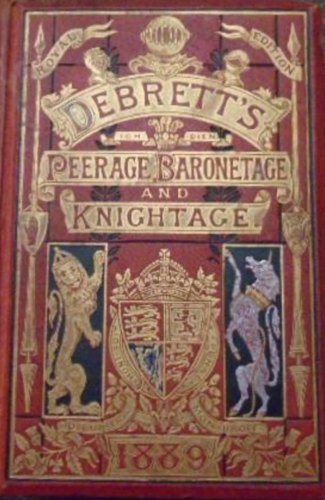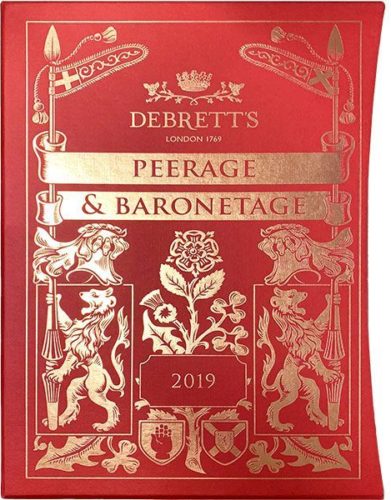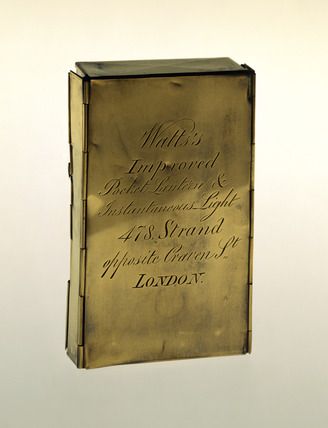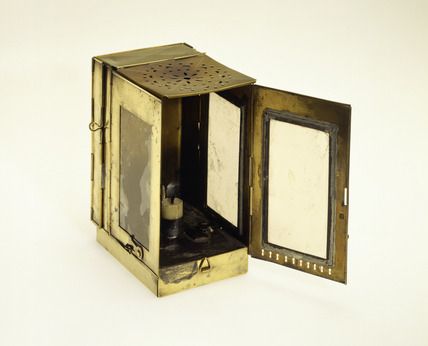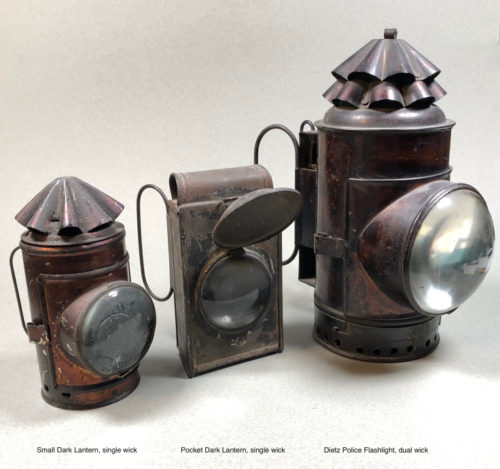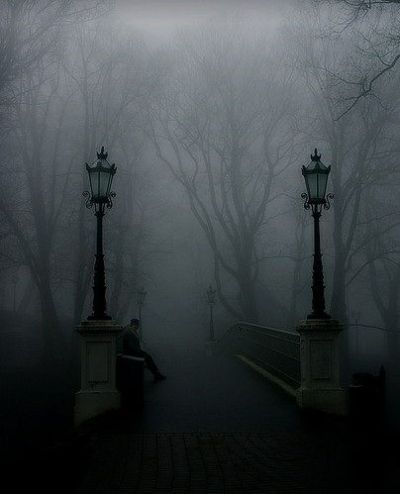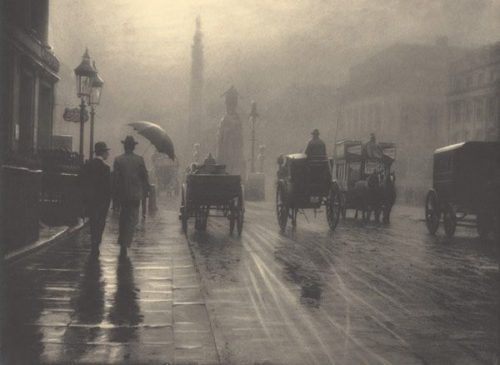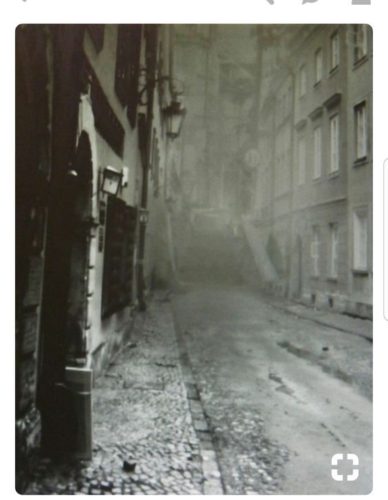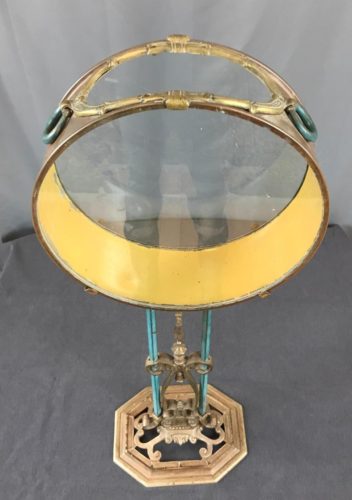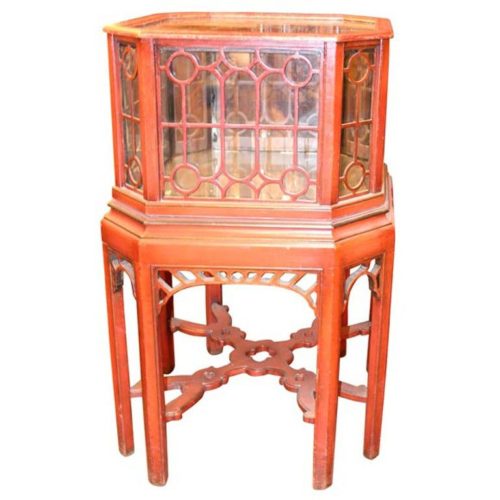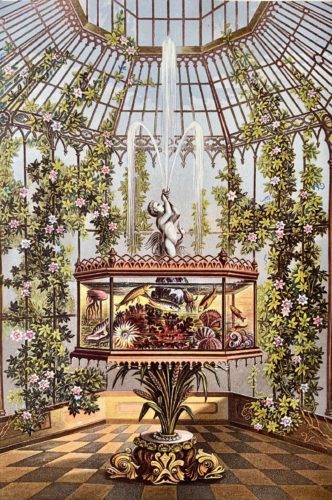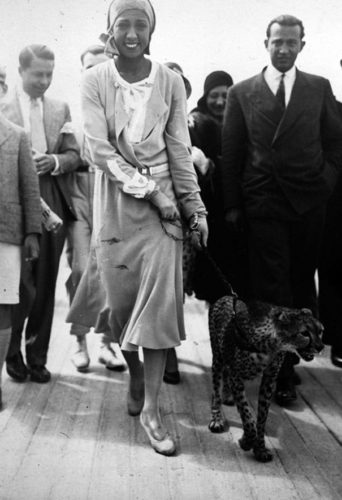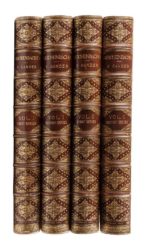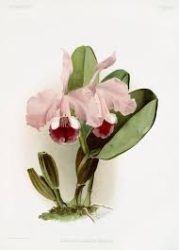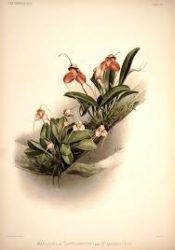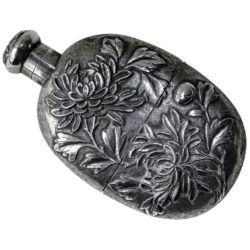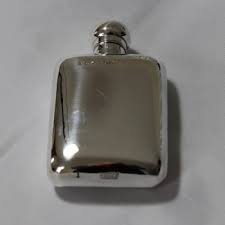 The Devil's Due
The Devil's Due
For more information on the book, please see here.
(It is recommended that you read along with or after the book but don’t read ahead, as there are SPOILERS if you do)
Chapters
Annotations for the remaining chapters are coming soon.
CHAPTER ONE
1890 Russian Influenza
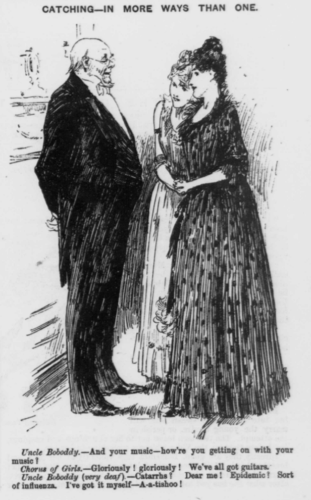
Courtesy Virginia Tech Universities Libraries
So called because it was first noted in St. Petersburg in December of 1889, this killer virus spread world-wide in a matter of four short months, partly due to increased transportation speeds of the newly expanded railways. In Britain four million sickened and over 27,000 died, from commoners to a grandson of Queen Victoria. Symptoms varied making diagnosis difficult, although alternating chills, fevers and sharp pains seemed to predominate. It presaged the even deadlier Spanish flu in 1918. Watson was lucky not to have caught this from a patient.
More on this here: https://academic.oup.com/shm/article/23/2/299/1646518
The Woman Question
Mentioned only in passing here, this term referred to one of the major areas of debate and challenge of the nineteenth century – the changing role of women. Challenges arose in the spheres of social life, the art world, business rights and property ownership, education and the conferring of degrees, credit for military and scientific achievement… and the minutiae of daily life both inside and outside the family. Holmes and Watson, while traditional gentlemen of their time, have variously indicated their forward thinking on this matter.
More on “the woman question” here:
CHAPTER TWO
The Illustrated Police Gazette
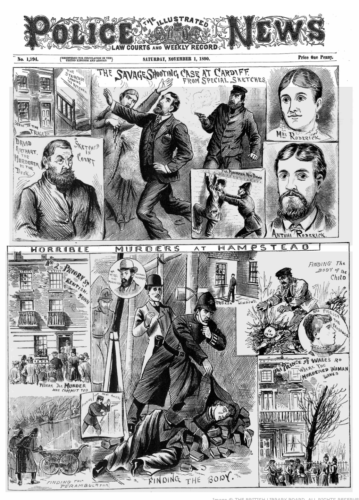
Holmes must be referring here to the infamous tabloid, The Illustrated Police News which ran weekly from 1864 to 1936. Who doesn’t love a juicy murder? This yellow rag was a guilty pleasure for most Londoners, fanning the usual flames of outrage, horror, fear, schadenfreude — shocking and titillating daily with illustrations of murders, violence, scandal and crime. Cheesy, but no doubt Holmes kept abreast of criminal doings and this was likely one of the many papers that entered 221B on a daily basis.
Here’s a typical cover, this one from the same month and year of our story.
CHAPTER THREE
Hyde Park
This park, a little farther from 221B Baker Street and south of it, would perhaps have been less preferred than the slightly closer Regent’s Park. But it offers beautiful walks, including along the man-made Serpentine waterway, and of course Rotten Row, where fashionable men and women went to see and be seen riding their flashy, well-groomed steeds. Wasp-waisted young women rode side saddle in bright dresses to advertise particular horses to the wealthy, and cards and pleasantries were exchanged. But this social whirl was anathema to Holmes and he and Watson avoided this on their walk, and instead strolled along the Serpentine, and ended up near the famous “Speaker’s Corner” where democracy and free speech were, and continue to be, on constant display.
The Serpentine
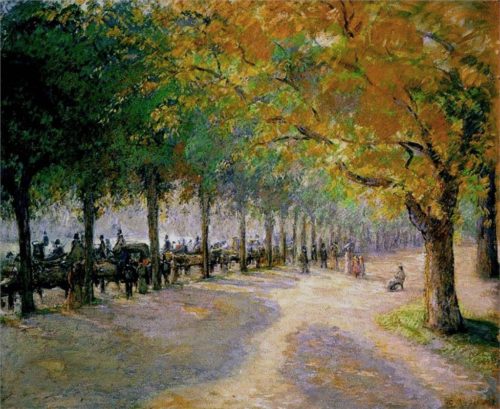
The Serpentine is a man-made lake created in 1730 and it is curved in shape, like a snake, hence the name. Seen here is Pisarro’s painting of it in Autumn, in the same year as this story, 1890. It is a scenic area, and still in use as a swimming venue for various competitions, including a Christmas Day race for the “Peter Pan Cup”. It has remained a favourite among Londoners for a peaceful stroll for over two centuries.
CHAPTER FOUR
Speaker’s Corner
The home of free speech, this has been the location for open debate since 1866. Traditionally, speakers were connected to the politics of the day and often with reform politics. Marx, Lenin, William Morris, the Pankhursts, all spoke here. Suffragette issues, and antiwar sentiment were hotly espoused here at the turn of the century and into World War One. By the 1940’s George Orwell described Speaker’s corner as "one of the minor wonders of the world", where he had heard "Indian nationalists, temperance reformers, Communists, Trotskyists, the Socialist Party of Great Britain (SPGB), the Catholic Evidence Society, freethinkers, vegetarians, Mormons, the Salvation Army, the Church Army, and a large variety of plain lunatics”. Speaker’s Corner still exists today, but with the advent of mass media and social media, there are fewer speakers and fewer listeners. Content has increasingly veered toward the religious. But in 1890, at the time of this story, the topics and speakers were quite varied.
Marble Arch
This edifice, at the edge of Hyde Park, has a bizarre history. Conceived by George IV’s favourite designer John Nash (who also did much of Buckingham Palace, Regent’s Park, Regent’s Street) it was to be the grand entrance to Buckingham Palace with the military theme of triumphant battles of the Napoleonic Wars.
Here’s the model for what Nash had planned:
But Nash was sacked when his patron died, and the plans were incomplete. With later changes to the Palace, it then seemed not to fit there and Nash’s replacement, Blore, had to piece together what might have been intended as Nash refused to release his designs. In any case, a de-emphasis on the military seemed more fitting to the times, In 1850, it was deconstructed stone by stone and reassembled in its current location, just in time for the 1851 Great Exposition. It is definitely a hybrid conception. Marble Arch still stands now where it did at the time of this story in 1890.
CHAPTER FIVE
Tarot Cards
Tarot, believed to have originated in Italy, has been around as a card game since the fifteenth century but not until the eighteenth did it take on a “divinatory” aspect. Watson has made one his more typical mistakes here. The De La Rue tarot deck, in common use then, had a skeletal “death” card and a dancing demon for “the devil”.
This is what typically happened when Watson, occasionally an unreliable narrator, worked years later from his youthfully scribbled notes. In any case, De La Rue was the premier playing card manufacturer for many years, putting out numerous decks for regular games, as well as for tarot. Pictured here is their impressive London location:
More about De La Rue here: https://www.wopc.co.uk/delarue/index
Simpson’s (Simpson’s on The Strand)
This London institution, a favourite restaurant of Holmes and Watson, originated as a chess club, and evolved into the famous restaurant which still exists. It is most known for superb roast beef which is wheeled on a silver cart by waiters who carve it for you tableside. It is a favourite place for Sherlockians to visit in London, and retains much of its vintage charm. Simpson's is mentioned in The Dying Detective, and also in The Illustrious Client, although in this story Watson mentions sitting at “a small table in the front window and looking down at the rushing stream of life in the Strand” — which is no longer possible in the dining room, now on the ground floor.
Beau Brummel
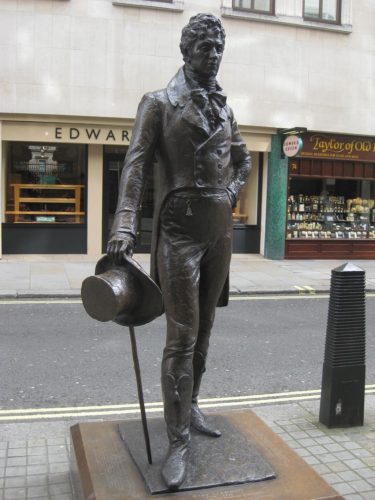 When Watson refers to the Goodwins as “veritable Beau Brummels of our time” he’s referring, of course, to the famous Eton and Oxford-educated dandy of Regency England, known for his glamorous dress, extreme stylishness, wit, and charm. When we consider the word “dandy” now, something perhaps foppish and overly fancy comes to mind, but in fact Brummel had a simpler taste, and the trends in clothing which he initiated had to do with better tailoring, and extremely careful personal hygiene. Brummel enjoyed the prestige of a close friendship with the Prince Regent (later King George), but unfortunately Brummel fell out with him. To avoid debtor’s prison, Brummel fled to France, where he did well for awhile, but then slowly descended into ignominy, and finally madness, dying under pitiful circumstances at an asylum in Caen. This statue of him Jermyn street shows Brummel in his handsome prime.
When Watson refers to the Goodwins as “veritable Beau Brummels of our time” he’s referring, of course, to the famous Eton and Oxford-educated dandy of Regency England, known for his glamorous dress, extreme stylishness, wit, and charm. When we consider the word “dandy” now, something perhaps foppish and overly fancy comes to mind, but in fact Brummel had a simpler taste, and the trends in clothing which he initiated had to do with better tailoring, and extremely careful personal hygiene. Brummel enjoyed the prestige of a close friendship with the Prince Regent (later King George), but unfortunately Brummel fell out with him. To avoid debtor’s prison, Brummel fled to France, where he did well for awhile, but then slowly descended into ignominy, and finally madness, dying under pitiful circumstances at an asylum in Caen. This statue of him Jermyn street shows Brummel in his handsome prime.
The Luminarians
No such group exists in record. Perhaps Watson renamed this group, or perhaps it is a deliberate attempt to cover up what seems to us a unique moment in British politics, though certainly one can imagine such clandestine organisations could exist, then and now.
CHAPTER SIX
“..inexperienced young men fooling with explosives”
Mycroft’s rather dismissive description of the anarchists was not far from the mark. While many anarchists were experienced protestors, and quite a few driven by idealism rather than a desire to destroy, there was a component that fits this description quite well. Four years after this story, a very real young man, Martial Bourdain, 26, managed to blow himself up while carrying a chemical bomb through Greenwich Park, near to the Observatory, pictured here.
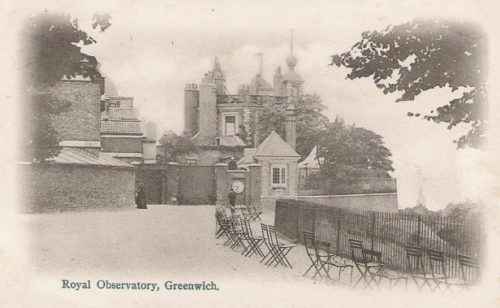
CHAPTER SEVEN
Fitzrovia
 This area of London was where many French immigrants lived, and as many of them had fled the various revolutions, it followed that there was a lively political flavour to the neighbourhood. It was considered by the British establishment to be a hotbed of anarchists, and indeed many famous ones lived in the area. But anarchists were not all violent, many were far more interested in social reform, the rights of workers, the poor, and women -- and in education for all.
This area of London was where many French immigrants lived, and as many of them had fled the various revolutions, it followed that there was a lively political flavour to the neighbourhood. It was considered by the British establishment to be a hotbed of anarchists, and indeed many famous ones lived in the area. But anarchists were not all violent, many were far more interested in social reform, the rights of workers, the poor, and women -- and in education for all.
But of course there were those ready to fight, and die, for these ideas.
More info on the French in Fitzrovia here: https://libcom.org/history/-small-anarchist-republic-french-anarchists-fitzrovia
Le Bel Epicier - Victor Richard
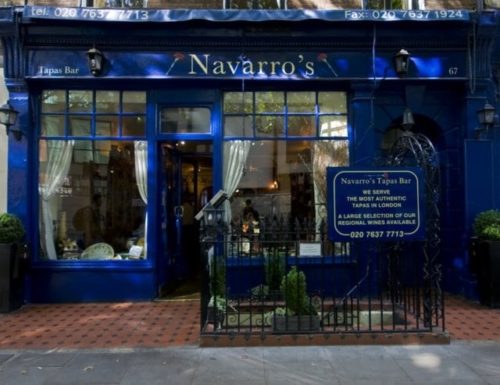 Le Bel Epicier (The beautiful grocer) was a very real shop in Fitzrovia, at 67 Charlotte Street, (now a Tapas restaurant -and a quite good one -- called “Navarro’s”)which was run by one Victor Richard, a very real and important figure among the French anarchists who clustered in this neighborhood at the time. Le Bel Epicier was indeed known for its coffeemakers, and French delicacies. However there was a basement area which was used for meetings of the anarchists. Holmes, with his elevated gastronomic taste (except when working) and his French ancestry would easily have been a patron, not only for the food, but for the gossip that he —fluent in French —could easily pick up. It appears in this story that he frequented it in the guise of a “Stephen Hollister” a rather naive and enthusiastic writer who spoke no French at all.
Le Bel Epicier (The beautiful grocer) was a very real shop in Fitzrovia, at 67 Charlotte Street, (now a Tapas restaurant -and a quite good one -- called “Navarro’s”)which was run by one Victor Richard, a very real and important figure among the French anarchists who clustered in this neighborhood at the time. Le Bel Epicier was indeed known for its coffeemakers, and French delicacies. However there was a basement area which was used for meetings of the anarchists. Holmes, with his elevated gastronomic taste (except when working) and his French ancestry would easily have been a patron, not only for the food, but for the gossip that he —fluent in French —could easily pick up. It appears in this story that he frequented it in the guise of a “Stephen Hollister” a rather naive and enthusiastic writer who spoke no French at all.
See the article linked to above for Fitzrovia.
Peugeot Coffee Grinder
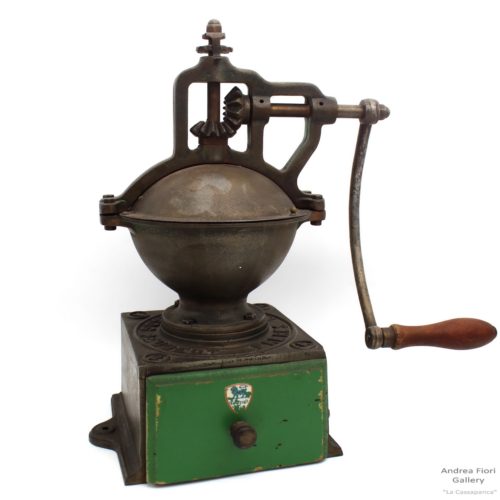 The special coffee grinders which Victor Richard introduced to his customers was most likely one of these, by Peugeot. We think of Peugeot as a car manufacturer but this innovative and rather steam-punkish late 19th century coffee grinder was the company’s first product, and it was the remarkable profits from it that funded the development of the classic French automobile! We know from the stories that Holmes and Watson were dedicated coffee drinkers in the morning, and having a better grinder would have suited them both. If they could get Mrs. Hudson used to it, that is.
The special coffee grinders which Victor Richard introduced to his customers was most likely one of these, by Peugeot. We think of Peugeot as a car manufacturer but this innovative and rather steam-punkish late 19th century coffee grinder was the company’s first product, and it was the remarkable profits from it that funded the development of the classic French automobile! We know from the stories that Holmes and Watson were dedicated coffee drinkers in the morning, and having a better grinder would have suited them both. If they could get Mrs. Hudson used to it, that is.
Louise Michel and The Autonomie Club
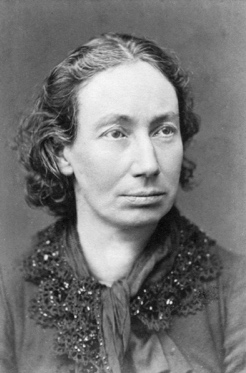 While Louise and The Autonomie only get the briefest of mentions here, they played key roles in the French anarchist movement of this era. Years earlier, Louise had been instrumental in violent activities of The Paris Commune, for which she was deported. She returned to France, and earlier in 1890, she fled to England.
While Louise and The Autonomie only get the briefest of mentions here, they played key roles in the French anarchist movement of this era. Years earlier, Louise had been instrumental in violent activities of The Paris Commune, for which she was deported. She returned to France, and earlier in 1890, she fled to England.
Louise was a battle-scarred heroine who is legendary in France for running an ambulance service during the height of revolutionary battle, her pacifist, feminist views, and her desire to see the poor educated. Louise was first and foremost a crusader for the poor and downtrodden. At the time of this story, she ran The International Anarchist School in London for children of political refugees, a school which emphasised “scientific and rational methods.” Michel's aim was to develop among the children “the principles of humanity and justice.” While never an advocate of violence, Holmes would have found much to agree with in this theory of education.
The Autonomie Club was nearby at 6 Windmill Street, another Fitzrovia centre for anarchists to gather.
More on Louise here: https://en.wikipedia.org/wiki/Louise_Michel
“Vagrant individuals begging on the streets”
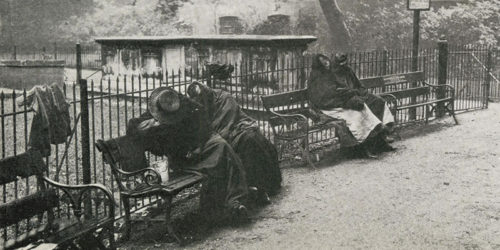 Watson remarks upon the homeless people he sees along Euston Road. In 1890, the homeless population during this period in London was far larger than it is even now. They could be seen anywhere, on park benches as in this photograph, in beautiful areas of town as well as destitute areas. Women and children made up the majority. There were several stages of sleeping rough – from cheap shared lodgings where theft and disease was rampant, sleeping on the streets, and as a very last resort, the workhouse. Workhouses offered the destitute a roof and meals but separated families and resembled jail to most of the inhabitants. Few recovered to resume productive lives once there. The largest workhouse in London was in Marylebone, on Marylebone Road, only two blocks from Baker Street. The author’s flat abuts the area that was the Insane Men’s Courtyard of that Workhouse.
Watson remarks upon the homeless people he sees along Euston Road. In 1890, the homeless population during this period in London was far larger than it is even now. They could be seen anywhere, on park benches as in this photograph, in beautiful areas of town as well as destitute areas. Women and children made up the majority. There were several stages of sleeping rough – from cheap shared lodgings where theft and disease was rampant, sleeping on the streets, and as a very last resort, the workhouse. Workhouses offered the destitute a roof and meals but separated families and resembled jail to most of the inhabitants. Few recovered to resume productive lives once there. The largest workhouse in London was in Marylebone, on Marylebone Road, only two blocks from Baker Street. The author’s flat abuts the area that was the Insane Men’s Courtyard of that Workhouse.
More on the homeless population of Victorian London can be read here:
https://www.redpepper.org.uk/seeking-shelter-the-houseless-poor-of-19th-century-london/
CHAPTER EIGHT
A silk reticule
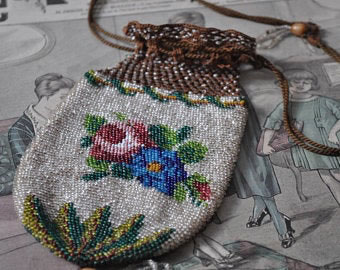 This was a small purse made of silk, velvet or satin, often highly decorated with embroidery, beadwork, tassels or flowers, in which ladies of the time carried their “necessaries”. Usually they had a drawstring at the top. This fine example was for sale on Etsy at the time of this writing. They came in various sizes.
This was a small purse made of silk, velvet or satin, often highly decorated with embroidery, beadwork, tassels or flowers, in which ladies of the time carried their “necessaries”. Usually they had a drawstring at the top. This fine example was for sale on Etsy at the time of this writing. They came in various sizes.
This marvellous pinterest site has many stunning examples of Victorian reticules and one can find sewing and knitting patterns to make your own. https://www.pinterest.co.uk/pin/161496336617308068/?lp=true
Schools for Fallen Women
During the last half of the nineteenth century, prostitution was regarded as one of the worst evils of society and it became quite popular among the upper classes to fund and run charitable institutions to “rescue fallen women” -- (forget about the men, it was the women’s problem!) Nevertheless these refuges did offer many women a second chance. They were variously called “houses”, “penitentiaries” and some were schools where young women were educated to work in service. Lady Eleanor Gainsborough was in good company in setting up one of these well-regarded institutions and hers appears to have a practical approach -- teaching an alternate trade. Twenty years earlier, Christina Rossetti, sister of Dante Gabriel Rossetti volunteered at such a “house” in Highgate, and was an increasingly feminist voice as a result of what she experienced.
More on Christina and this subject here:
https://www.bl.uk/romantics-and-victorians/articles/christina-rossetti-gender-and-power
CHAPTER NINE
Mayfair and Grosvenor Square
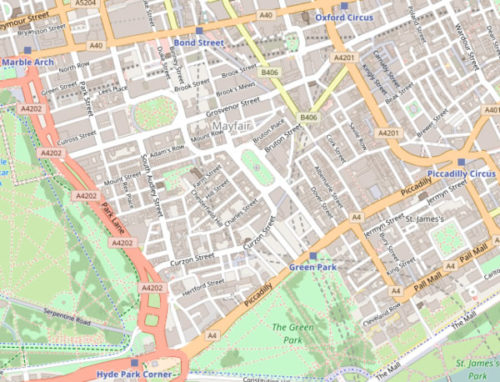 One of the richest and most expensive locations in London, and indeed the world, for a long time leading up to our story, and still today. Marylebone and Baker Street are directly to the North, Hyde Park and Green Park abut it to the East and South, and Grosvenor Square (pronounced Gruv-ner) is its centrepiece. Although not geographically far from Baker Street, it was a world away in status and wealth. There was an actual May Fair the first two weeks of May for centuries, shut down in the late 18th century for being too raucous.
One of the richest and most expensive locations in London, and indeed the world, for a long time leading up to our story, and still today. Marylebone and Baker Street are directly to the North, Hyde Park and Green Park abut it to the East and South, and Grosvenor Square (pronounced Gruv-ner) is its centrepiece. Although not geographically far from Baker Street, it was a world away in status and wealth. There was an actual May Fair the first two weeks of May for centuries, shut down in the late 18th century for being too raucous.
A huge house on or near Grosvenor Square as described by Watson would have been the epitome of upper class living in London of the time. As there are no homes with the type of driveway described by Watson in this tale, we can only surmise the Goodwin Brothers lived nearby.
Fortnum and Mason and The Scotch Egg
Fortnum and Mason, since 1707 the purveyors of excellent prepared foods, teas, jams, sweets and more, is famous for its picnic hampers full of goodies. Only the wealthy then and now could afford regular provisions from this gourmet specialty emporium.
The Scotch Egg, a staple British snack, was invented there. It is a hardboiled (though sometimes a bit runny in the centre) egg surrounded by a layer of sausage, and then breaded on the outside. It was highly portable and would have been the perfect snack to sustain Holmes and Watson on their many long adventures, as it could be wrapped and brought along in one’s pocket.
Fortnum and Mason is on most visitors’ "must see" list, or should be. An astonishing array of tasty, quintessentially British goods are on offer.
Can't get to Fortnum and Mason's? Here's a recipe for their Scotch Eggs:
https://www.food.com/recipe/fortnum-and-masons-authentic-scotch-eggs-with-sausage-and-herbs-408043
Ganja
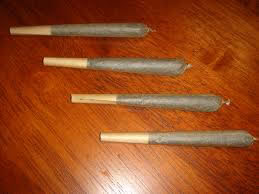 While Watson is of course familiar with marijuana, called Ganja here, from his time in India, he is rather naively surprised to find one of the Goodwin brother’s partaking. As straightlaced as we imagine Victorian London to be, there were plenty of people of all classes who enjoyed smoking weed on a regular basis, socially as well as “medicinally” (it was also available as a tincture). Of course it was a somewhat “bohemian” thing to do. Earlier in the century it had been touted as a wonder drug but by this time it was looked at by some as the cause of insanity and depravity. Watson’s astute observation on why this would not be Holmes’ drug of choice rings true.
While Watson is of course familiar with marijuana, called Ganja here, from his time in India, he is rather naively surprised to find one of the Goodwin brother’s partaking. As straightlaced as we imagine Victorian London to be, there were plenty of people of all classes who enjoyed smoking weed on a regular basis, socially as well as “medicinally” (it was also available as a tincture). Of course it was a somewhat “bohemian” thing to do. Earlier in the century it had been touted as a wonder drug but by this time it was looked at by some as the cause of insanity and depravity. Watson’s astute observation on why this would not be Holmes’ drug of choice rings true.
More info on the history of Cannabis in Britain is here: http://www.strangehistory.net/2016/02/15/30990/
CHAPTER TEN
Pimlico
Lestrade’s home is in Pimlico, the area between Victoria Station and Chelsea, and just south of posh Belgravia (which some Sherlockians will recognize as Irene Adler’s neighborhood in BBC Sherlock.) Pimlico now is rather upscale but at the time of Watson’s writing in 1890, it was a residential area with blocks of varying levels of income, mostly middle class - “comfortable”. This is evident on the Booth’s Poverty map, the multicoloured map shown here. Its relative proximity to New Scotland Yard would have made it desirable for Lestrade to live there. Also pictured is Warwick Street in Pimlico.
Spitalfields
This East End area has a long and colourful history. “Spital” is a Middle English short form of hospital, and St. Mary’s hospital and priory was founded here in the late 12th century. French Huguenot weavers later thrived here and it was the centre of silk weaving for a time. When weaving became industrialized and silk fell out of favour, the area declined rapidly and at the time of this tale it had plunged into deep poverty and was riddled with crime. The Booth Poverty maps show many gray (poor) areas. The pictures give you a flavour of the place.
The name is familiar to many for it was in the dank alleyways of Spitalfields and Whitechapel, (just south of Spitalfields), that Jack the Ripper cut a bloody swath, only two years prior to this tale. In 1890, Some areas of Spitalfields were so dangerous that no policeman would venture in alone, including near the pub Watson searched for Heffie and Holmes. The entire East End has evolved to become a rather hip and artistic area now, with hotels that cater to a younger crowd.
More on Spitalfields here: http://spitalfieldslife.com/2011/09/19/unveiling-the-map-of-spitalfields-life/
The Snake and Drum
This is probably a name Watson fabricated as he so often did, as it is impossible to locate on maps of the era. Signs for pubs and shops originally were iconographic such as this one, as many originated in an era when the literacy rate was low, particularly in poorer areas. The Snake and Drum sign pictured here was designed for the book by the artist Mark Mázers.
CHAPTER TWELVE
Belgian herding dog
 Holmes recognizes the dog which followed him home as a Belgian herding breed, and it was most likely to be what we now know as a Bouvier de Flanders, pictured here. One might easily share Watson’s thought that this creature resembled the bear rug which sat in front of the fireplace at 221B.
Holmes recognizes the dog which followed him home as a Belgian herding breed, and it was most likely to be what we now know as a Bouvier de Flanders, pictured here. One might easily share Watson’s thought that this creature resembled the bear rug which sat in front of the fireplace at 221B.
Toby
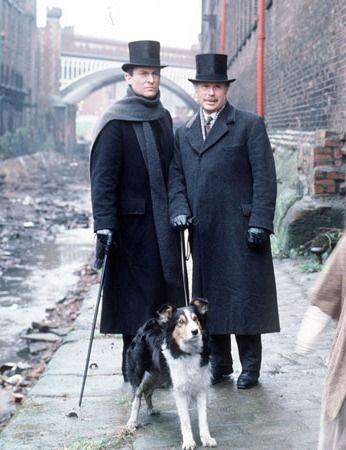 In Watson’s recounting of The Sign of Four, which takes place in 1888 (two years earlier by most accounts) Holmes makes use of a tracking dog named “Toby”. During that adventure, he asked Watson to fetch Toby from his owner, Sherman, in Lambeth. Says Holmes of Toby, “…a queer mongrel, with a most amazing power of scent. I would rather have Toby’s help than that of the whole detective force of London.” And so in looking for a home for the enormous dog that has followed him home here, he thinks of Sherman once more. Pictured, Holmes and Watson with Toby from Granada’s series.
In Watson’s recounting of The Sign of Four, which takes place in 1888 (two years earlier by most accounts) Holmes makes use of a tracking dog named “Toby”. During that adventure, he asked Watson to fetch Toby from his owner, Sherman, in Lambeth. Says Holmes of Toby, “…a queer mongrel, with a most amazing power of scent. I would rather have Toby’s help than that of the whole detective force of London.” And so in looking for a home for the enormous dog that has followed him home here, he thinks of Sherman once more. Pictured, Holmes and Watson with Toby from Granada’s series.
CHAPTER THIRTEEN
The Baguette
 Long, crispy crusted, and fabulous, the baguette is a staple food of the French and the devoted Francophile. And when stale, this long loaf of bread makes a suitable club for beaning someone. Recommended sandwich --a “jambon beurre”… a baguette sliced the long way, with French butter, French ham… and nothing else. Yes, indeed. Picture of a baguette courtesy of King Arthur Flour. And in case you get hungry reading this, here’s how to make your own.
Long, crispy crusted, and fabulous, the baguette is a staple food of the French and the devoted Francophile. And when stale, this long loaf of bread makes a suitable club for beaning someone. Recommended sandwich --a “jambon beurre”… a baguette sliced the long way, with French butter, French ham… and nothing else. Yes, indeed. Picture of a baguette courtesy of King Arthur Flour. And in case you get hungry reading this, here’s how to make your own.
https://tasteofartisan.com/french-baguette-recipe/
“Le Pain Francais”
“Pain” being French for bread, the pun is complete. French baker M. Pateau who supplied the French anarchists with their staple baguettes once was taunted by a group of religious zealots for “working on a Sunday”. “To which he responded by striking them about the head with one of his flutes with the hardest crust. Later he quipped “to distribute pains there is nothing like le pain Français!” Nick Heath
The source for this and what follows is Nick Heath’s “French Anarchists in Fitzrovia”.
https://libcom.org/history/-small-anarchist-republic-french-anarchists-fitzrovia
Borough Market
Mentioned here as a location for a planned bombing, Borough Market has existed in the same place for a thousand years. The present-day market was constructed in 1850 and so looks as it did in Watson’s story of 1890. The drawings below are from 1860 and 1872, the vertical one is by Gustave Dore. The modern market today caters mainly to retail customers with many food stalls selling British and foreign delicacies --teas, beer, candies, cupcakes, cheese, sushi, taffy, chocolates, cured meats, and you name it.
The Humor of the Real French Anarchists
Victor Richard, the grocer, was a very real person – and was very much about protecting the French revolutionaries who had taken refuge in London. This was very real danger, but the French maintained a sense of humour about it all.
On the serious side, “...the generous Burgundian” was always willing to extend credit to revolutionary exiles and much of the money he made was spent on the cause in one way or another, including funds on at least one occasion for French revolutionaries hounded in Britain to enable them to leave the country”.
When his shop was raided four years after this story, a hilarious cheat sheet for the French to learn English slang was found. It included the following entries:
French: Donnez-moi un shilling
Written English: Give me a bob
Spoken English (how to pronounce): G’hive mi é bob
French: Fermez ça !
Written English: Shut up !
Spoken English (how to pronounce): Chotte ap!
French: Je vous mettrai mon pied dans le derriere
Written English: I will put my foot on your bottom
Spoken English (how to pronounce): Aill ouille poute maille foute one your botome
The Baguette Brigade and Shaming the French Police Who Came To Arrest the French Anarchists
This rather long and funny tale from Nick Heath details how some of the Frenchmen sent to England were outwitted and more or less “shamed” into going home.
Over time, “French surveillance from the French state on the exiles in London increased. … Inspector Prosper-Isidore Houillier of the Sûreté… arrived in London, with the connivance of Inspector Melville of Special Branch. “Le vil Melville” (the vile Melville) as he was known to the exiles was a sworn enemy of anarchism and he was once again breaking the rules in allowing the French cops to operate in London.
Houillier seems to have spent a lot of his time eating at the best London restaurants, apparently all at the French public’s expense. On the track of the anarchist Meunier, the cops were given a tip-off that he was holed up at 30 Charlotte Street.
On arriving there they were surrounded by a large crowd of anarchists, and serenaded with revolutionary songs accompanied by the barrel-organ played by the colourful anarchist Zo d’Axa. Uniformed police had to be sent in to get the cops out of the sticky situation.
“Ending on [an even] lighter note, we turn to the anarchist baker Pateau who supplied bread to the French exiles. He is fondly remembered by Cohen, as is his bread “fragrant, dark golden French bread that is nothing like the under-done, unsavoury, chalky, corpse-pale ‘loaves’…that the English eat”. He made deliveries both in Fitzrovia, Soho and the suburbs. Once making a Sunday delivery in suburban London he was confronted by a group of religious bigots who had just left the chapel “where they had refreshed their souls” and were waiting for the Spotted Dog pub to open “where they could quench their thirst with a gin and bitters or a pint of pale ale”. They chastised him for working on a Sunday to which he responded by striking them about the head with one of his flutes with the hardest crust. Later he quipped “to distribute pains there is nothing like le pain français!”
“On another occasion Houillier and his SB pals followed removals vans around London that they had mistakenly linked to anarchist fugitives. …
Finally, Houillier was lured to a pub on Great Portland Street full of French anarchists. …Houillier became conscious of the crowd in the pub all staring at him. Some had taken out large clubs which they were leaning on. He turned pale. After a heavy silence, M…, a Parisian anarchist, raised his pint of bitter and proposed a toast “To the French police, so well represented here today by our excellent friend Houillier, by our old chum Houillier!”
The anarchists lined up to shake his hand whilst M.. continued “Something tells me that he has leave England very soon, and we must give up all hope of seeing him again. He should know that we will always guard a memory of his good manners and excellent meals that we will never relinquish. Hurrah for comrade Houillier!” Houillier was finally allowed to leave the pub after many more sarcastic toasts.”
“The humiliation was not over for him, however. The following morning, arriving at Charing Cross to take the train to Folkestone, he was welcomed by a large crowd of anarchists, who helped him with his luggage and accompanied him to his compartment. There they lavished him with advice that he could have expected from his mother, warning him against cold draughts and other hazards of the journey. M.. implored him: “At least promise us that you will write to us”! As the train set off, the anarchists following it along the platform waving their hats and handkerchiefs and crying out “Vive Houillier!”
CHAPTER FOURTEEN
Mephistopheles and the Faust Legend
 Mephistopheles is the Devil’s right hand and appears in the Faust legend as a black dog which follows Faust home and then turns to human form, tempting him into selling his soul to the devil. This is Erwin Schott as Mephistopheles in the recent production of Gounod’s Faust performed at the Royal Opera House in London in 2019, exactly where Holmes has just seen the same opera in 1890.
Mephistopheles is the Devil’s right hand and appears in the Faust legend as a black dog which follows Faust home and then turns to human form, tempting him into selling his soul to the devil. This is Erwin Schott as Mephistopheles in the recent production of Gounod’s Faust performed at the Royal Opera House in London in 2019, exactly where Holmes has just seen the same opera in 1890.
The Royal Italian Opera
This was the name in 1890 for what is now known as The Royal Opera House in Covent Garden. It is still very much as it was in Holmes’s time, and here is a picture of it in 1897, just nine years after this story takes place.
CHAPTER FIFTEEN
Cyanide
Cyanide is a poison which is found in natural substances such as almonds, lima beans, and the pits and seeds of apricots, apples and peaches. Industrially It is used in developing photographs, metal cleaning, and removing gold from ore. To some, it has a bitter almond smell but not everyone can smell cyanide. That is crucial to what happens in this scene. Cyanide prevents the cells from using oxygen and can cause brain and lung damage, enough ingested will cause respiratory failure.
CHAPTER SIXTEEN
The Ammoniaphone
Yes, this was a real thing which enjoyed a vogue among singers, music students, and sufferers of asthma, bronchitis and other breathing difficulties.. Invented by Dr. Robert Carter Moffat, a Glaswegian medical man (who coincidentally shares the same last name with Glaswegian Steven Moffat, co-creator of BBC Sherlock), this medical device was said to improve the voice by delivering a batch of chemicals which would create a breathing environment similar to Italian air…. And Italy was known for producing the world’s best singers. Dr. Moffat introduced this to London in January of 1885 in talk and demonstration in St. James Hall and a fad was born. Quack medicine at its most idiosyncratic.
CHAPTER SEVENTEEN
The Nippers or Come-Alongs
This diabolical handcuff was originally designed for use when escorting prisoners to and from cells, to the courtroom, or for subduing violent prisoners. The advantage was that the policeman could very easily control his charge and do so with the simple twist.
There were two main types of "nipper".. Each had a smaller, open ended cuff which quickly clamped shut over the prisoner’s wrist. The other end, held by the officer had either larger, closed loop - or a t-bar shaped handle. The officer was not linked to the prisoner (which could prove dangerous) rather he controlled him quite easily with one hand. They thus offered a considerable advantage to the policeman.
With a simple twist the officer could entice the prisoner to “come along” or indeed have him in an instant on the floor, writhing. Many police departments in Britain banned their use as the device ended up breaking many a wrist. That Titus Billings in this story brings them back is entirely within character.
Here are two variations from the nineteenth century. The two gold colour photos are of a “Lutz, Royce, Trenor and Chadwick” police Come Along and show the handle type. This one has three levels of tightness for different size wrists.
The silver coloured photo is a more common type made by Hiatt.
CHAPTER EIGHTEEN
A Broken Wrist
Without the benefit of x- rays (which were discovered in Germany in 1895, and such a good idea that they were being used in hospitals by 1896), doctors in 1890 had to rely on observation and palpation to determine the extent and location of broken bones.
Specialists called “bone setters” were called in, and traction had to be applied before the broken bones could be splinted in place, because with a break, the muscles around the broken bone contract, often pulling it further out of line. This very old illustration indicates a device invented for this traction, which took a great deal of physical force. In this case, the two doctors manage to traction the wrist without the need of such a thing.
Luckily by the time of this story in 1890, various painkillers were available to dull this extremely painful process.
But once tractioned, the wrist still presents problems. As you can see from the antique and modern depiction of the carpals, the wrist is made up of a very complicated set of bones. They are very much connected to the subtle movement of the fingers.
Immobilisation for too long by a wrist splint can permanently impair finger movement (and thus imperil violin playing). Too much movement of the fingers while the wrist is healing, however, could cause the carpals to heal incorrectly, or not to set at all.
CHAPTER TWENTY
“A Telephone is in our future, Watson”.
Here’s a beauty from five years later --1895, Swedish, but was in a house St. Pancras. Its decorative finish is black lacquer with gold. This photo and phone courtesy of The Museum of London.
The Telephone at Scotland yard was no doubt much less decorative.
Longing for a Victorian style phone in your home? Many working reproductions are available, this one from Wayfair. https://www.wayfair.com/decor-pillows/pdp/design-toscano-the-swedish-royal-family-replica-telephone-txg2556.html
For more on the history of telephones in Britain, read this:
https://owlcation.com/humanities/history-of-the-telephone-system-uk
Holmes’ Choice of Coat
Sack Coat
Dr. Watson in many modern depictions wears a sack coat, which is a boxier, less formal jacket than a frock coat, often buttoned at the top and open over the waistcoat bottom. Sometimes tweedy, more so in the “country” version.
The sleeves were usually wider on this type of coat (although not on Jude Law’s, seen here) and thus would have fit over the encumbrance of Holmes’s wrist in this scene.
Frock Coat
This more elegant coat was longer, nipped in at the waist, and with narrower sleeves. This was daytime formal wear in 1890 London and is the type that we see Sherlock Holmes wearing in many modern depictions. As he was quite slim, and over six feet tall (and looked taller), this attire would emphasize these attributes.
“Gin&Tonics” in Fedora Lounge an online haberdashery forum describes Jeremy Brett’s attire in the Granada series: “Mr. Brett wore a 3-piece black frock suit, single breasted, with self faced (not satin) notch lapels, I believe it was a 2 button. Early in the series, his waistcoat had notch lapels, whereas later on he wore a waistcoat without lapels. I believe both waistcoats were 2 pocket. I'm not sure of the treatment of his pants hem, though I feel as though they were sans cuffs. …. Also, if you're really going for the full look, he wore a batswing bowtie with the bows tucked under a point collar”
Might Makes (is) Right, or Survival of the Fittest
The actual title of this very real pamphlet was "Might IS Right". This heinous tract was believed to have been written by a man named Arthur Desmond. Originally a New Zealander, (or perhaps an Englishman, no one is quite sure) but reputed to be a frustrated, red-haired poet who fled his country, Desmond lived variously in Australia and the US under assumed names, and first published this pamphlet in Chicago in 1880 under the name "Ragnar Redbeard" - (no connection the BBC Sherlock dog, "Redbeard").
In blunt terms, it advocates violence and war, subjugation of the weak, dominance over women, stealing, murdering and plundering as a means to success, in other words survival not only of the fittest (men only) but those of the nastiest and most treacherous. The writer abhors democracy, the Golden Rule, Judeo-Christian morality and a host of other civilising influences. Sadly this tract has resurfaced in recent years and certain groups have seemed to find it inspiring. It has also held sway for various fascist organisations over the many years since it oozed onto the landscape in 1890.
In this story, the highly prejudiced Titus Billings represents the strongly anti-immigrant sentiment which existed among some in Britain at this time, as sadly it still does now. Billings advocates brutality, which in his influential position in the police department has the chance to wreak havoc. At this time British policemen did not carry guns.
Holmes and Watson are quite clear about what they think of this tract, the author, and his theories.
More in it here, if you must: https://rationalwiki.org/wiki/Might_is_Right
Social Darwinism
 This term was coined by French journalist and anarchist Émile Gautier (pictured) in his pamphlet of that name in 1880, Paris. The term has several meanings. All have to do with the notion of “survival of the fittest” and Darwin’s theory of natural selection.
This term was coined by French journalist and anarchist Émile Gautier (pictured) in his pamphlet of that name in 1880, Paris. The term has several meanings. All have to do with the notion of “survival of the fittest” and Darwin’s theory of natural selection.
Some proponents of social darwinism believed that in the correct social order, the strong should naturally dominate the weak -- and take from them, liberally, whatever they could. In other words, some people were just inherently better than others and therefore naturally deserving. This version of the theory, when taken to harsh extremes, has over the years been connected with fascism, imperialism, racism, eugenics and social inequality.
As it is in direct opposition to theories of democracy, The Golden Rule, and justice-- not to mention the chivalry of defending those who cannot defend themselves-- Holmes and Watson would most naturally find these ideas abhorrent.
Holmes’ Spectacles Joke
Holmes makes a joke about a social darwinist who idealizes strength and perfection, but overlooks his own weakness (must wear spectacles because he can’t see without help).
DeBrett’s
At the time of the story, a reference to “DeBrett’s” refers to the publication that lists all the peerage, their lineage, their family members, a veritable who’s who (as well as who was who) among the British aristocracy. Pictured below is the 1889 version which is probably the one pulled down from the shelf by Watson.
Also pictured is the 2019 version which DeBrett's claims will be the final printed version.
Debrett's also publish (since the mid 19th century) manuals of style, manners, and etiquette. You can still buy relatively recent ones online if, for example, you are unsure of what to wear to country house weekend, or how to address royalty.
Pocket Lantern
Mrs. Hudson makes sure that Holmes and Watson bring along their pocket lanterns. While these small lights would not cut through much fog, at least they would allow the boys to be seen, and have less chance of being run over. The gold coloured example here, closed and open, is from the Museum of London, a little earlier in the century but similar to what they might have carried with them.
In addition is a photo with two “dark lights” – the largest being the type the police would carry. The middle one is a pocket lantern. These could be clipped to the lapel or pocket of a jacket to illuminate things while leaving the hands free.
CHAPTER TWENTY-ONE
Victorian London in the fog
Pea soupers (yes, even called that then) were more common in Victorian times, when the weather was harsher than it is now. The Thames would regularly freeze over in winter, allowing “Ice Fairs” to be held on the surface. The fogs were unhealthy and dangerous, not only for the lack of visibility, but also because the damp air was laden with coal dust and unregulated industrial waste, making it difficult to breathe. The pollutants from the many factories in and near the city could sometimes make the fog take on poisonous tints, yellow, pink, green.
Victorian Aquariums
The Victorian mania for collecting and cataloguing flora and fauna gave rise to the home aquarium, also inspired by Charles Darwin’s long sea voyage, and the fiction of Jules Verne. Whatever was underwater in the sea -- or even Loch Ness -- became an object of both speculation and fascination, and it became stylish for wealthy homes to display miniature ocean bottoms in fancifully designed aquariums such as those you see here. The third, an illustration of one in a solarium is probably closest to the one described in the glassed-in atrium of Lady Gainsborough’s home in this story, although hers was much larger. The orange one is a true Victorian specimen, of the late 19th century decorated in Chinoiserie which reflects another fad for all things Asian. The round, disc-like aquarium dates later, from 1924, but the stand is distinctly Victorian in style.
For more on Victorian Aquariums:
Belle the Pet Leopard
 Belle, of this story might have looked like this beauty - a "clouded leopard" who escaped from his pet enclosure in Cornwall in 2019 and killed several sheep before being caught in a fox trap and returned to his owner - who used to keep the poor beast in a garden in London.
Belle, of this story might have looked like this beauty - a "clouded leopard" who escaped from his pet enclosure in Cornwall in 2019 and killed several sheep before being caught in a fox trap and returned to his owner - who used to keep the poor beast in a garden in London.
Clouded leopards, like this one, are now among the rarest animals on the endangered list. Leopards, by all reports, do not make good pets, they are not completely tameable even when hand reared by humans. But wealthy and eccentric people have always gravitated toward unusual pets. Here is Josephine Baker, star of the twenties and thirties with her pet cheetah (Cheetahs have spots; Leopards have rosettes)
The Reichenbachia
This word will sound familiar to Sherlockians, for it was at the Reichenbach Falls that Sherlock Holmes faced off his deadly rival Professor James Moriarty. But here, eerily presaging this encounter which was to happen later the following year, Holmes is referring to the famous (and very real) illustrated masterpiece by German orchidologist Frederick Sanders . This work was named in honour of the famous German orchidologist Heinrich Gustav Reichenbach and is a kind of orchid encyclopedia which presents orchids in life-sized colour renderings. A multi volume edition as described in Watson's writing and some coloured plates from this book are pictured.
Technical information about the book can be found here: https://core.ac.uk/download/pdf/51290196.pdf
Majlis
This word meaning “council” or a place to meet and discuss, also came to refer to the type of seating found in such places, and this comfortable, low-to-the-ground lounging sofa, well known in Arab culture, might have been seen in Victorian London in Turkish baths and occasionally in Eastern-influenced salons of wealthy people — where it would have been regarded as somewhat bohemian. This picture is from a modern shop in Dubai.
CHAPTER TWENTY-TWO
Pentonville Prison
Opened in 1842, located in the Islington, Pentonville is still in operation as a major British prison. It was not typical for prisoners awaiting trial to be sent there, but that is where Danforth has been sent. Famous inmates included (for a time) Oscar Wilde, and Arthur Koestler. It is, at the time of this annotation, currently undergoing severe cockroach problems.
The personal flask
Carried by many gentlemen, usually with brandy, the Victorian “cure-all” and frequently employed by Watson. Some carried whisky. Flasks came in a variety of shapes, sizes and degrees of decoration or personalisation. One would imagine Watson with a simple flask, perhaps with his initials, as suited a former army doctor. And with brandy, most typically.
Alcoholism
Neither Holmes nor Watson are alcoholics, although many kinds of drinks are mentioned in the canon and they share port, brandy, whisky and sodas, fine wines over the course of their years together. Sherlock Holmes is addicted to work, and, arguably, to injections of cocaine or morphine, but not to alcohol, and it would be highly improbable to see him inebriated in public. Holmes uncharacteristically asks Watson for a sip of his brandy while interviewing the prisoner, precisely to confirm his suspicion that Charles Danforth is indeed addicted and uses this handily to elicit the information he needs in exchange for the prisoner’s desperate gulps from Watson’s stash. Alcoholism was not well understood at the time and alcoholics were jailed, institutionalised, given emetics, shocked, or later, even lobotomised in various unsuccessful attempts to cure or contain them.

